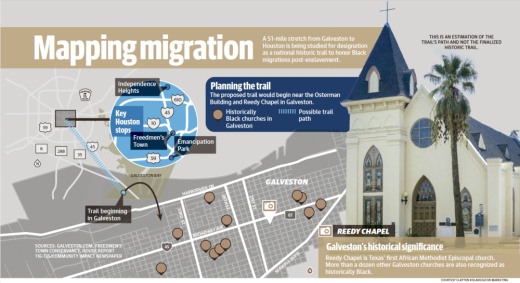As celebrations took place in Old Galveston Square for Juneteenth—now a federal holiday that honors the day Union Gen. Gordon Granger came to Galveston to announce the liberation of enslaved people in Texas—cyclists honored the holiday’s history through a ride along a historic path.
National Park Service officials are studying a 51-mile stretch of land from Galveston to Houston for potential selection as one of just two trails in the United States honoring Black history. A group of about 50 cyclists gathered over the weekend of June 19 to ride the Houston-Galveston path, known as the Emancipation Trail, in celebration of Juneteenth with a stop in League City as part of the ride, according to a city of League City news release.
The route is considered to be the same route taken by formerly enslaved people and others leaving Galveston after Granger informed them of their liberation. A feasibility study is being conducted for the trail’s designation as a national historic trail, after Congress in 2020 approved an amendment to the National Trails System Act allowing for new designation.
The trail would begin near the Osterman Building and Reedy Chapel in Galveston, go along Hwy. 3 and I-45 to Freedman’s Town, then go to Independence Heights and end in Houston’s Emancipation Park. It would be one of just two trails in the country commemorating the migrations of formerly enslaved people, with the other being from Selma to Montgomery, Alabama. Read more about the trail and its history here.
Along the Juneteenth weekend ride, cyclists stopped at historically important sites including League City’s Butler Longhorn Museum, according to the June 23 news release. Click here to view photos from the ride.
Participants viewed an exhibit on enslaved people who worked as cowboys, and League City Mayor Pat Hallisey was on site to greet the cyclists and offer refreshments to the group, per the release. They also stopped in Texas City, where the only Reconstruction-era Black settlement in Galveston County was located.
After the trail study is complete—which could take around 30 months total, according to the release—its findings will be presented to Congress, and Congress will vote to officially designate the trail as a National Historic Trail. Click here to track the project’s progress on the NPS website.





